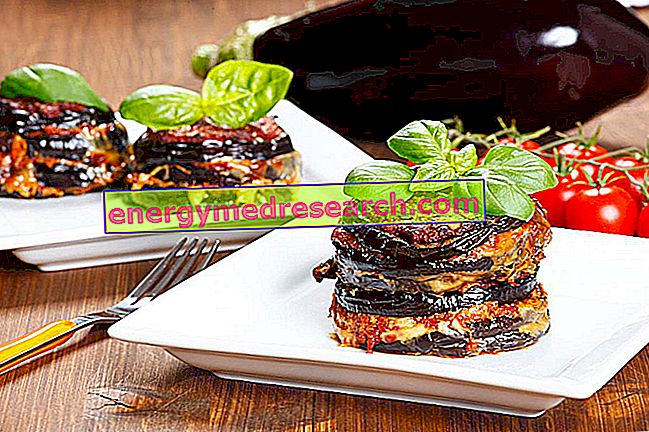Generality
Vegetable meat is a group of man-made foods, highly proteinic MAs exclusively structured from ingredients derived from the Kingdom of Plants.

Vegetable meat is the result of food handling aimed at obtaining some products that can replace animal meat, fishery products, milk, derivatives and eggs; not surprisingly, vegetable meat is frequently used in lacto-ovo-vegetarian and vegan diets.
Essentially, vegetable meat is able to bring excellent protein concentrations but, as can be deduced, it does not have the same nutritional characteristics as food of animal origin.
Types and Production
The main types of vegetable meat currently on the market are seitan and wheat muscle .
Seitan
Seitan is the vegetable meat (or better, wheat meat ) par excellence; not surprisingly, the literary translation of the westernized Japanese term corresponds to the adjective "proteic". The production of this kind of vegetable meat takes place by mixing wheat, purifying water-soluble components and pre-cooking in boiling liquid. The raw material for the use of seitan is wheat flour with high concentrations of gliadins and glutenins (strong or special flours: W> 280, up to> 400), such as durum wheat semolina or manitoba . The mixture is made by mixing flour and water. As for washing, instead, it is a much more laborious procedure; it is carried out by first soaking followed by several consecutive rinses in hot and cold water; in this way, the water-soluble components of the flour (carbohydrates, most of the vitamins and mineral salts) come out of the mixture, purifying the edible gluten network (gliadins + glutenins in the presence of water). Once the seitan mixture is purified to the right point, it is pre-cooked in a vegetable broth; this can be composed to taste but traditionally it should contain: water, soy sauce, kombu seaweed, ginger and salt. Seitan-type vegetable meat can then be served by baking or in a pan or grilled.
Wheat Muscle
Wheat muscle is a different vegetable meat than seitan. While the latter is obtained by purifying the wheat flour, the wheat muscle is composed by mixing and mixing powdered gluten, legume flour and flavorings, without further depriving it of the water-soluble portion. The wheat muscle is produced by mixing (similar to bread or pizza) powders and aromas (curry, curcuma etc.) with water; once a NON-sticky and homogeneous compound is obtained, it is necessary to precook it in water or broth, giving it a specific roast shape by means of a cylinder and a food net. This vegetable meat can be preserved by refrigeration, immersed in its own cooking liquid, and served by finishing in the oven or in a pan or on the griddle.
Mopur
Very similar to the wheat muscle, it differs from the latter in the presence of yeast, which gives the product greater softness, reducing its guminess.
Nutritional properties
Vegetable meat CANNOT completely replace animal meat. Certainly these are well-structured foods which, due to their nature, are scarce in various nutritional components. At the same time, both the seitan and the wheat muscle boast some chemical merits of which (in some cases) it is possible to draw many benefits. More in detail.
Advantages of vegetable meat
vegetable meat, in principle, does NOT contain either cholesterol or high percentages of saturated fats; on the contrary, in the case of wheat muscle, it is possible to use a good portion of monounsaturated and polyunsaturated fatty acids (based on the type of leguminous flour used). This makes it extremely useful in food therapies against hyperlipemias, as the presence of ω3, ω ‰ 6 and ω ‰ 9 favors the improvement of cholesterolemia (total and relative to the LDL / HDL balance) and triglyceridemia. Furthermore, α-linolenic acid helps to reduce levels of arterial hypertension and systemic inflammation.
Vegetable meat provides good portions of dietary fiber, phytosterols and lecithins more in the wheat than in the seitan. All these components have a positive health effect as, synergistically with polyunsaturated and monounsaturated fatty acids, they contribute to the improvement of lipemia on two very distinct fronts: dietary fiber and lecithins intervene in the reduction of intestinal lipid absorption; in parallel, both lecithins and phytosterols interact with the body at a metabolic level, promoting the improvement of cholesterolemia. Furthermore, dietary fiber has a protective action on the intestinal mucosa, reducing and preventing constipation (which, in addition to preventing colon tumors, improves quality of life).
From a certain point of view, the vegetable meat (plus the wheat muscle compared to the seitan) allows to obtain a greater nutritional balance among the energy molecules. By making a variable amount of complex carbohydrates, vegetable meat lends itself more to animal than in the composition of unique dishes, reducing the consumption of bread and potatoes, to the benefit of practical use and avoiding the abuse of these foods in the accompaniment of dishes. In parallel, due to the modest amount of starch, the vegan diet does NOT risk exceeding the portion of total carbohydrates at the expense of proteins (a fairly common drawback among those who consume only cereals, legumes and tubers).
The biological value of the proteins contained in the wheat muscle is better than that of the cereals or legumes observed individually. This is due to the mutual compensation of the limiting amino acids, respectively lysine for wheat and (generally) methionine and cysteine for legumes. This determines the achievement of a HIGH overall biological value, despite the average value of the starting protein ingredients. The leguminous flour most suitable for compensating the biological value of vegetable meat is undoubtedly that of soy.
Vegetable meat also helps to maintain the correct ratio between vegetable and animal proteins, respectively 2: 1/3: 1 in the adult and 1: 1 in the growing subject.
Implications and complications
Vegetable meat, as anticipated, is not without its implications and possible complications; let's list some of them.
First, both seitan and wheat muscle contain gluten. This protein constitutes a "pseudo-allergen" responsible for adverse reactions in intolerant subjects, also called celiacs. Celiac disease is therefore a (more or less serious) form of food intolerance which (and hence the use of the term pseudo-allergen) is also responsible for the onset of immune-mediated mechanisms. In practice, vegetable meat is NOT ABSOLUTELY suitable for the celiac diet.
At the same time, the presence of soy determines the most total exclusion of the wheat muscle in the diet of the allergic to these proteins. Furthermore, let us remember that certain legumes are the triggering agent of a very serious genetic disease, favism. In the presence of some molecules, this pathology determines the inhibition of glucose-phosphate-6-dehydrogenase (G6DP) and the consequent destruction of erythrocytes (red blood cells).
Vegetable meat, being cooked, CANNOT be included among the foods used in raw food; moreover, unlike the foods that characterize the vegan diet, lacto-ovo - vegetarian and raw food (raw fruit and vegetables), the vegetable meat DOES NOT provide an amount of active antioxidants such as to characterize an anti-tumor nutritional regime (main characteristic of high vegetable diets).
Defects
The vegetable meat, as opposed to the animal one, DOES NOT comply with the nutritional requirements of cobalamin or vit. B12. This molecule, which is essential for the body, is involved in the structuring of nucleic acids and a possible deficiency would negatively affect the production of hemoglobin (oxygen transport protein in red blood cells) causing "pernicious or cyto-megaloblastic anemia", and spina bifida in the fetus of a pregnant woman.
Furthermore, contrary to the animal, vegetable meat does NOT contain ferric iron. The bioavailable iron deficiency negatively affects the production of hemoglobin and induces an anemic form called "sideropenica". In the adult male subject this deficiency is less severe than in the female, which, in addition to having to compensate for menstrual bleeding, requires pregnant rations of iron that are difficult to reach even with animal flesh (which is rather rich).
The same is true for calcium, present above all in wheat muscle compared to seitan, but which (often also bound in calcium oxalate) is not as bio-available as animal. Partial calcium deficiency mainly affects bone growth and maintaining skeletal integrity in old age.
Vegetable meat, particularly wheat muscle, contains several anti-nutritional or chelating molecules. Among these the phytates and tannins stand out, but in theory the oxalates should also be present; these components "bind" some mineral salts inside the digestive tract preventing it from passing through the intestinal mucosa.
The digestion and absorption of proteins contained in vegetable meat is not optimal. In addition to using a lower biological value, vegetable proteins have an absorption coefficient 19% lower than that of animal meat. Furthermore, according to the evaluation scale used by the WHO, seitan proteins have a lower PDCAAS: 75% compared to those of whey, 66% compared to soybean and 43% compared to those of White beans.
Homemade wheat muscle
See also the recipe for vegetable meat stew based on wheat muscle and the green pepper fillet with vegetable meat.
Homemade Wheat Muscle - Meat for Vegetarians
X Problems with video playback? Reload from YouTube Go to Video Page Go to Video Recipes Section Watch the video on youtubeHomemade Seitan
Directly from the vegan recipes section, we offer the video recipe to learn how to make seitan at home.
Homemade Seitan
X Problems with video playback? Reload from YouTube Go to Video Page Go to Video Recipes Section Watch the video on youtubeFor those who buy ready-made seitan, we suggest the video-recipes on the homemade seitan ragù and on the vegan chickpeas crepes with seitan ragù. Also not to be missed is the home-made video and soy burgers and vegan soy meatballs.
Mopur Home-made
Mopur - Vegetable Meat
X Problems with video playback? Reload from YouTube Go to Video Page Go to Video Recipes Section Watch the video on youtube



